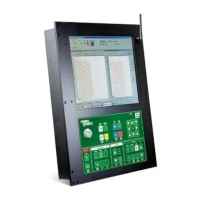iCNC Performance
Manual 0-5401 iCNC SETUP 7-7
• Max trial run speed is normally set equal to the Max settable speed.
• Min settable speed is set to your lowest dependable speed. The system enters this value in automatically after complet-
ing the Min speed test.
• Parking speed is used for max machine positioning and drift correction, either while the machine is standing still, or
positioning to a part location. Small values will make it impossible to properly position the machine.
• P-Gain (0 – 255) A critical gain setting controlling system responsiveness and performance. If the encoders are driven
directly off the motor shafts, a value of 190-210 works well in most cases. If the encoders are separately mounted and
measure off the machine carriage, this value may need to be dropped as low as 75.
• 45° dampening can be increased from the default value of 100 if vibration is seen, especially when driving at a 45°
angle.
• External stop slowdown time controls the reaction time between when an external stop input is received, and when
the controller halts motion.
• Acceleration and Deceleration controls the responsiveness when positioning the machine. With fast plasma machines,
a value of 35-50 mg is normal. If the machine is mechanically very rigid, with near zero backslash and a strong drive
system, you might be able to use values as high as over 100 mg. For slow gas cutting machines, a value of 15 mg is
normal. Both acceleration and deceleration values are generally adjusted equally.
NOTE!
One G (the value describing how fast an object accelerates when dropped to a free fall on earth) is 9.81 m/s/s. Therefore 10
mg (milli-g) is 0.0981 m/s/s or 9.81 cm/s/s
• Centrifugal acceleration will limit the maximum speed of the machine when driving on small radius arcs or approach-
ing sharp corners. This must be set to a value equal-to or less-than your acceleration or deceleration values, and can
be set as low as 3 mg.
• Corner slowdown level value for sharp corners. Affects the allowed speed for sharp corners, too low value will cut
away the part being cut, too high value will make rounder corners.
• Corner angle w/o slowdown specifies the maximum corner angle to be driven without any speed limitations. 15000
mdegrees is same as 15 degrees.
• Automatic drift adjustment is not available with step/dir command.
• Acceleration S-Curve Enabled enables/disables S curve acceleration for smoother motion with high acceleration values.
• The Y2 adjust screen is not available with Step/Dir command.
Applying Settings
1. First press Apply to temporarily store the parameters before running the test Rosette.
2. When running the test Rosette, it is necessary to watch actual machine motion, and therefore you should have your
drives engaged to the pinion rack.
3. Pressing the Test run button will allow you to run a test Rosette of desired size and speed. The test starts when you
click the Start button and press the MOVE AHEAD push button on the controller’s front panel. When motion is ok click
Save and Close.
NOTE!
After completing this section, it is advisable to do a total restart and password-save the changes permanently when
prompted.

